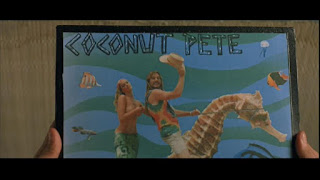by A.J.
Happy Halloween! The countdown is over and Halloween is finally upon us. Tonight, hopefully, you'll be relaxing, eating some candy, and watching a scary, or not-so-scary, movie. There are a lot of options for tonight and I hope I've been of some help. Here is my final recommendation to help bring an end to Shocktober:
Night 13: Happy Happy Halloween!
“I think you’re referring to my song Pina Colada-burg.”
Club Dread (2004)
To follow up the hilarious film Super Troopers, the comedy troupe Broken Lizard turned their
style of comedy to the slasher movie. The result is Broken Lizard’s Club Dread, a self-aware horror-comedy
that is as bloody as it is funny. It works as a comedy and as a horror-slasher movie; and since it features a hilarious performance from the late Bill Paxton, I
couldn’t think of a better movie to close out this Shocktober.
Club Dread takes place on Pleasure Island, a tropical spring
break style party resort. The island paradise is owned by Coconut Pete (Bill Paxton), a mostly washed
up Jimmy Buffet-esque musician whose song Pina Colada-burg would’ve been a
bigger hit if not for a certain Jimmy Buffet song. College age kids arrive on
the island for a nonstop party, but a masked killer starts murdering the staff
members one by one. The remaining staff try to keep the murders a secret from
the party guests while trying to figure out the identity of the killer. The
staff are played by the Broken Lizard members. The standouts of the group are Jay Chandrasekhar (who is also the director) as Putman, the tennis instructor with a vague,
indeterminable accent and a comical mass of dreadlocks, and Kevin Heffernan as
Lars, the new masseur with a close to magic touch. The female lead is Brittany Daniel who plays Jenny, the aerobics instructor that has all the men
tripping over themselves.
Instead of just making fun of horror movie clichés and
tropes, Club Dread uses those elements for comedic effect. The killer, like all
slasher movie killers, lurks and moves slowly towards his running victims. One
girl runs and gets into a golf cart that moves so slow the killer almost passes
her as he walks. The killer leaves clues too, and the staff has to interpret the
silly lyrics of Coconut Pete’s songs to find out who is going to be killed next.
In a great self-aware moment Jenny is all alone in her cabin and getting ready
to take a shower while there is a killer on the loose. She decides against the
cliched shower scene. Jenny, like any Final Girl is resourceful and level
headed, but unlike the typical Final Girl, Jenny is blonde and sexually active.
The movie gets some jokes out of Jenny’s promiscuity, but it never judges her
for that.
The cast, Broken Lizard or not, is incredibly likable and
fun to be around for an hour and forty-five minutes. Even the non-professional
comedians are very funny. Bill Paxton is great to watch as a beach bum musician
that can’t remember the lyrics to his songs or even making the albums. He’s no
stranger to comedic roles and knows just how to deliver the Broken Lizard
material. He has a lot of fun playing Coconut Pete and passes that fun along to
the audience. Plus, it’s great to hear Paxton sing ridiculous beach songs.
Club Dread is great horror movie fun from beginning to
end. The blood and gore, though plentiful, are not too intense. This movie never
loses sight of its main goal: to make sure everyone has a great time. It’s
clear that the Broken Lizard team knows and loves horror movies. Their movie follows the plot points of a slasher movie, but Broken
Lizard uses that template for their own unique version. They find fun ways to poke fun at each slasher cliché. My
favorite comes when the killer reveals his identity but forgets the reason he’s
killing everybody. There’s so much to enjoy here, even if you don’t like horror movies. I highly recommend
Club Dread for a spooky-fun Shocktober night.



















































